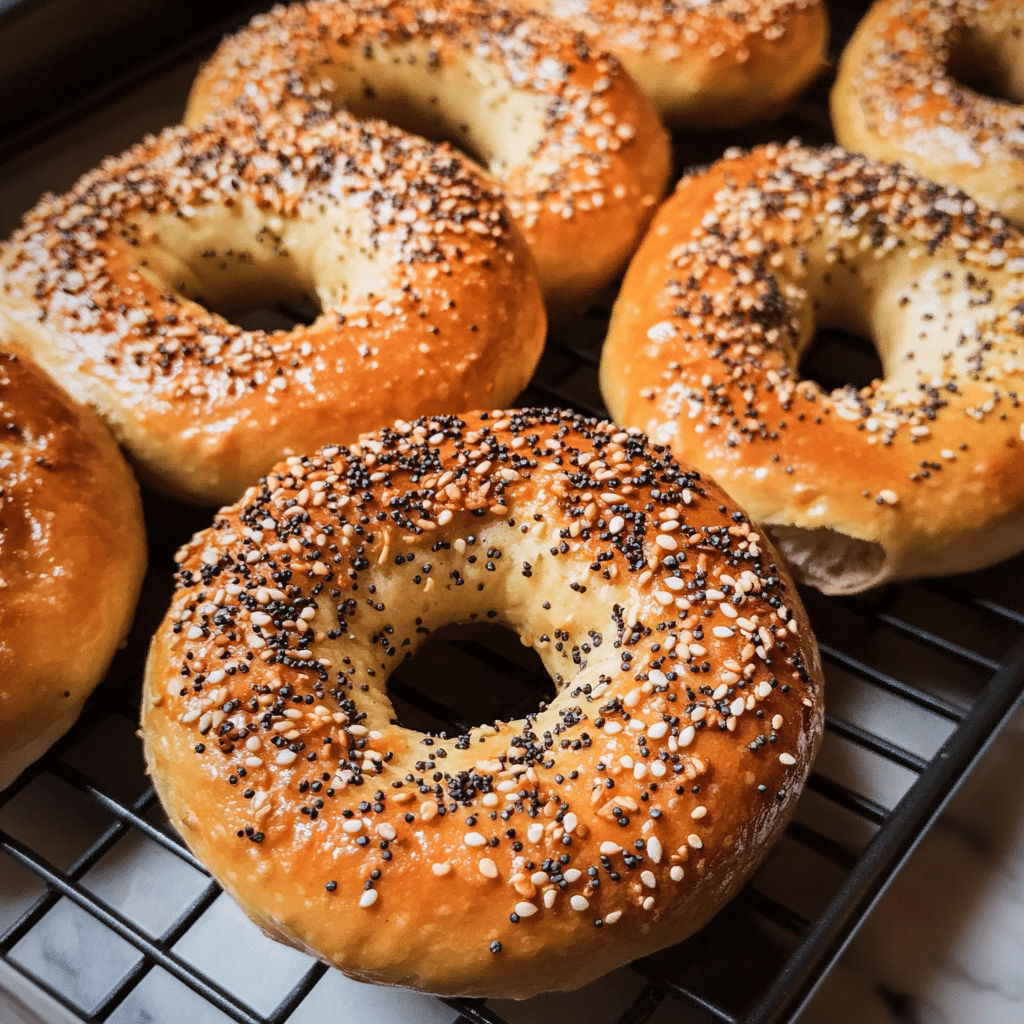Are you tired of carb-heavy breakfasts that leave you hungry an hour later? It might be time to upgrade your morning routine with something smarter—protein bagels. These power-packed alternatives to traditional bagels are more than just trendy: they’re functional, filling, and surprisingly easy to make or buy. Whether you’re working on your gains at the gym, managing your weight, or just want a balanced start to your day, protein bagels deliver the goods.
In this guide, we’ll dive deep into everything you need to know: from what makes them special to DIY recipes and protein-boosted topping ideas. We’ll even break down the difference between store-bought vs homemade, and clear up some popular myths along the way.
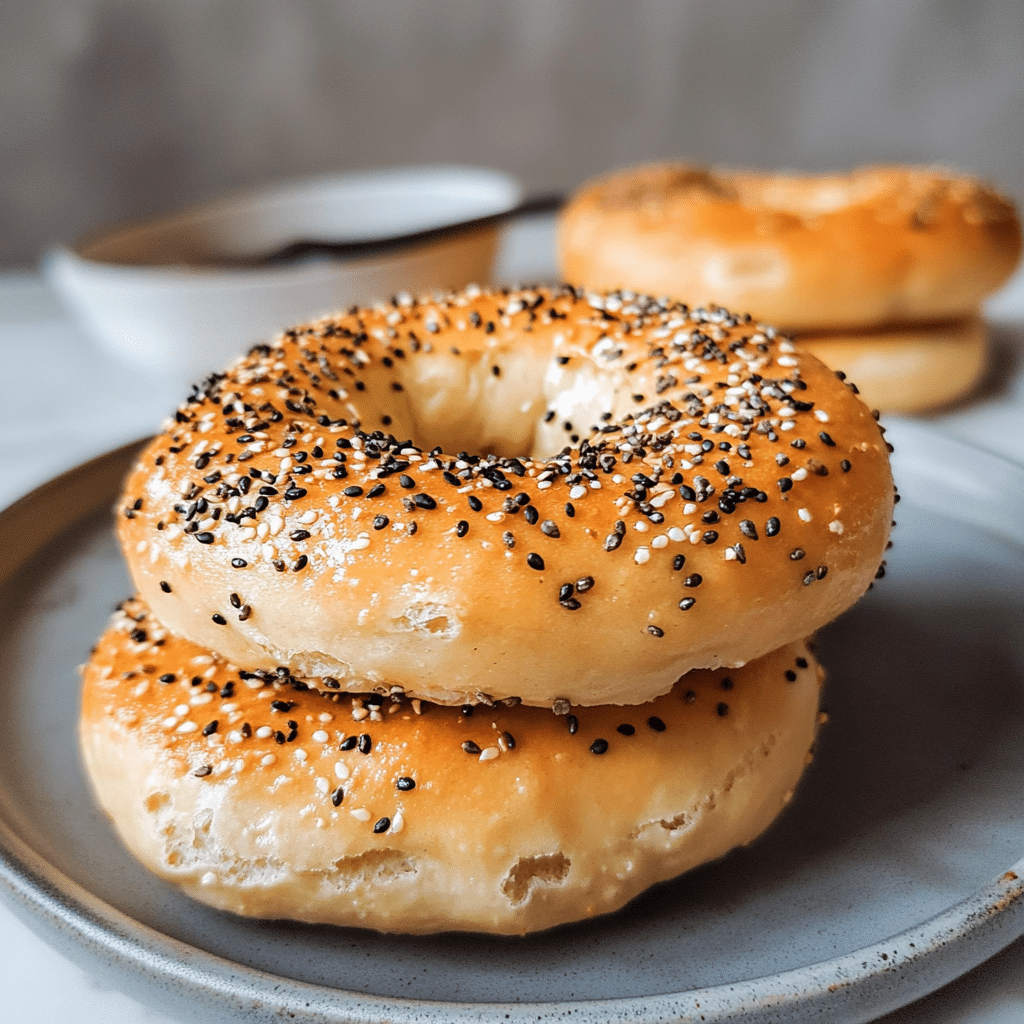
Table of contents
Table of contents
- What Are Protein Bagels and Why You Should Care
- Top Ingredients Used in Protein Bagels
- Popular Store-Bought Protein Bagels Ranked
- Homemade Protein Bagels – 2-Ingredient and Full Recipes
- Topping Ideas – How to Add Even More Protein to Your Bagel
- When and How to Eat Protein Bagels for Fitness Goals
- Comparing Protein Bagels vs Regular Bagels
- Protein Bagel Myths and Mistakes to Avoid
- FAQs About Protein Bagels Answered
- Conclusion: Are Protein Bagels Worth It?
What Are Protein Bagels and Why You Should Care
Definition and Nutritional Overview of Protein Bagels
So, what exactly are protein bagels? Simply put, they are bagels made with added protein sources such as Greek yogurt, whey protein, or egg whites to boost their nutritional profile. A traditional plain bagel contains roughly 9 grams of protein, but a protein bagel can deliver anywhere from 15 to 25 grams per serving—almost triple the usual amount.
Here’s a quick breakdown of a typical protein bagel’s nutrition compared to a regular one:
| Nutrient | Regular Bagel (100g) | Protein Bagel (100g) |
|---|---|---|
| Protein | 9g | 18g – 25g |
| Carbs | 50g | 25g – 35g |
| Fat | 1g – 2g | 2g – 5g |
| Calories | ~250 kcal | ~180 – 220 kcal |
This makes protein bagels a solid option for people aiming to control blood sugar, feel fuller longer, or support muscle repair and growth.
Health Benefits of Choosing High-Protein Alternatives
Opting for protein bagels isn’t just a fitness fad—it has real health benefits, including:
- Increased Satiety: Protein is more filling than carbs, helping you curb cravings and reduce overall calorie intake.
- Muscle Support: Especially post-workout, consuming protein supports recovery and muscle growth.
- Better Blood Sugar Control: Lower-carb, higher-protein foods help keep your energy levels stable.
- Weight Management: Studies suggest high-protein breakfasts reduce mid-morning snacking.
Don’t miss our comforting Neiman Marcus Chicken Casserole for another protein-rich idea that works for lunch or dinner!
Print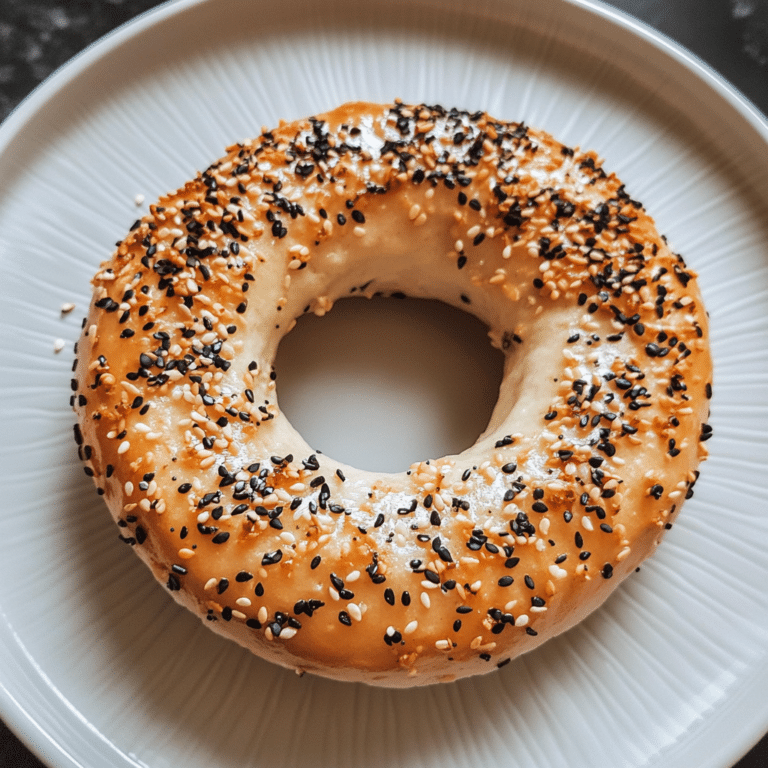
Protein Bagels – The Best High-Protein Breakfast Boost You Need Now
Ditch carb crashes and fuel your day with protein-packed bagels that support muscle, satiety, and balanced nutrition.
- Total Time: 35 minutes
- Yield: 4 bagels 1x
Ingredients
- 1 cup self-rising flour
- 1 cup non-fat Greek yogurt
- Optional: 1 scoop unflavored whey protein
- Optional: 1 tsp garlic powder or everything bagel seasoning
Instructions
- Preheat oven to 375°F (190°C).
- Mix the flour and yogurt in a bowl until a dough forms. Add whey protein and seasoning if using.
- Knead until smooth, divide into 4 pieces.
- Roll into ropes and form into bagels.
- Place on a lined baking tray, brush with egg wash if desired.
- Bake for 25 minutes or until golden brown.
- Let cool before slicing and enjoy!
Notes
Each bagel delivers 15–20g of protein. Store in fridge up to 5 days or freeze for up to 1 month.
- Prep Time: 10 minutes
- Cook Time: 25 minutes
- Category: Breakfast
- Method: Baking
- Cuisine: American
Nutrition
- Serving Size: 1 bagel
- Calories: 180
- Sugar: 2g
- Sodium: 400mg
- Fat: 2g
- Saturated Fat: 1g
- Unsaturated Fat: 1g
- Trans Fat: 0g
- Carbohydrates: 25g
- Fiber: 1g
- Protein: 18g
- Cholesterol: 10mg
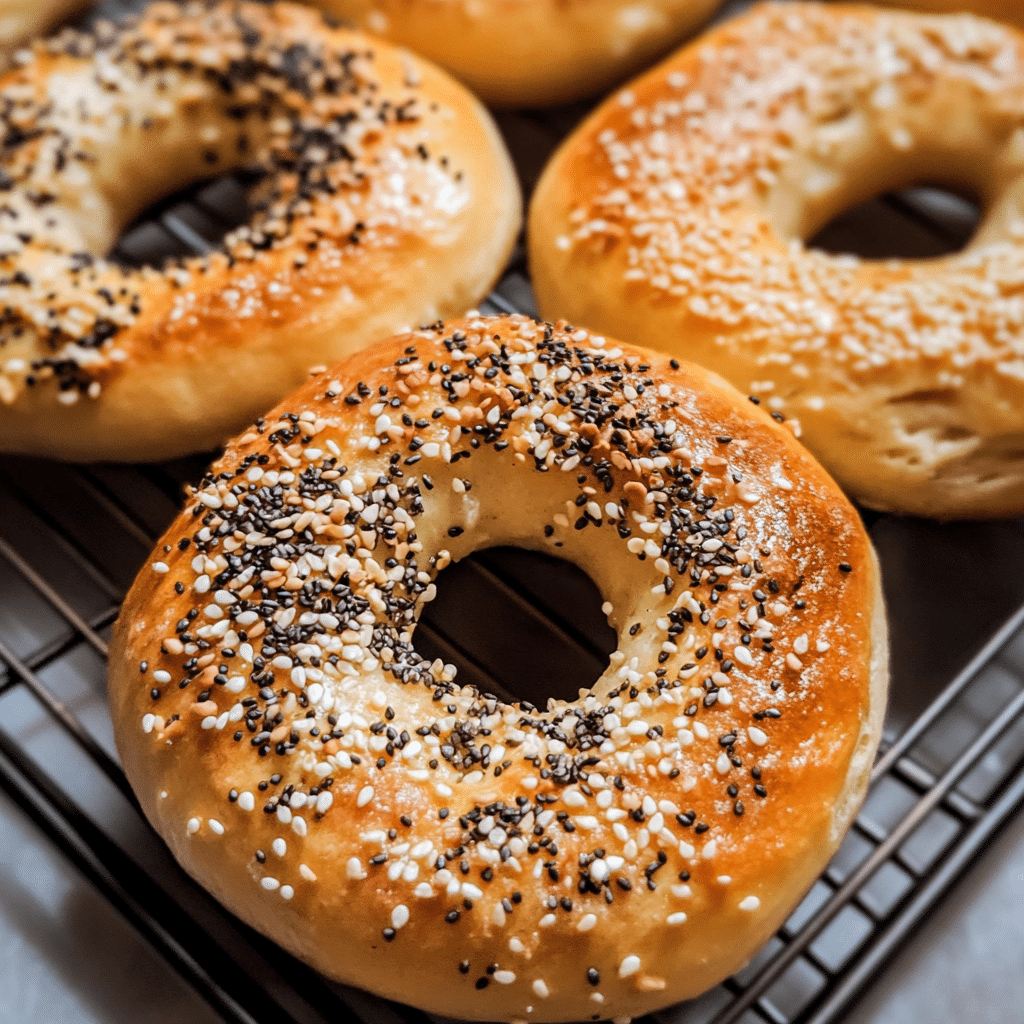
Top Ingredients Used in Protein Bagels
Common Protein Sources: Whey, Eggs, Greek Yogurt
Protein bagels aren’t magic—they just rely on clever ingredient swaps. These are the most popular protein-rich ingredients that bring nutritional value and great texture to the mix:
- Whey Protein Powder
A staple in fitness circles, whey protein adds a significant protein boost with minimal carbs or fat. It’s usually unflavored or vanilla-flavored when used in baking. One scoop can add 20+ grams of protein to a batch of bagels. - Greek Yogurt
Creamy, tangy, and packed with protein (about 17g per cup), Greek yogurt is one of the stars in the famous 2-ingredient protein bagel recipe. It acts as both a binder and a protein source. - Eggs or Egg Whites
Whole eggs offer protein and richness, while egg whites provide lean protein. Both improve the texture and increase the protein per serving. - Cottage Cheese
Yes, cottage cheese is also used in some variations—especially when aiming for a more moist and dense texture. And bonus: it’s high in casein protein, great for muscle repair. - Plant-Based Protein Powders (Optional)
For vegan options, pea or brown rice protein powders are great alternatives. They’re a bit grittier than whey but still do the job.
Check out our guide on fish taco seasoning to learn how to flavor any protein-rich dish with flair.
Whole Grain, Almond, and Other Flour Options
Now let’s talk flour. The type of flour you use can dramatically affect both the protein content and the texture of your bagels.
- Almond Flour: Grain-free, low in carbs, and high in protein (6g per 1/4 cup). It’s a common choice for keto-friendly protein bagels.
- Whole Wheat Flour: Offers more fiber and protein than white flour and gives a heartier taste.
- Oat Flour: Often used for gluten-free recipes, oat flour adds soluble fiber and a mild, nutty flavor.
- Coconut Flour: Used in small amounts, coconut flour adds density and fiber, but must be combined with high-moisture ingredients.
- Self-Rising Flour: Often seen in the 2-ingredient recipe—it simplifies the baking process, especially when combined with Greek yogurt.
By blending these flours with the high-protein ingredients above, you can maximize the nutritional impact without sacrificing taste or texture.
Popular Store-Bought Protein Bagels Ranked
Review of Thomas, Dave’s Killer, and Others
Not everyone has time to bake at home, and that’s perfectly fine. Luckily, several brands offer ready-to-eat protein bagels that are tasty and nutrient-dense. Let’s take a look at the most popular options:
1. Thomas’ Protein Bagels
- Protein: 13g per bagel
- Calories: 260
- Carbs: 43g
- Pros: Widely available, decent taste and texture, affordable.
- Cons: Slightly more carbs than other protein bagels.
Thomas’ Protein Bagels are one of the most accessible high-protein bagels on the market. They’re made with wheat gluten and soy protein isolate, which boosts protein while maintaining that traditional chewy texture.
2. Dave’s Killer Bread Epic Everything Bagels
- Protein: 13g per bagel
- Calories: 260
- Carbs: 48g
- Pros: Organic, whole grains, flavorful.
- Cons: High in sugar (8g), not low-carb.
Known for using organic ingredients, Dave’s Killer Bread delivers high flavor and clean-label nutrition. However, the slightly higher sugar content might not fit all diets.
3. Better Brand Bagels (The Better Bagel)
- Protein: 25g per bagel
- Calories: 170
- Carbs: 5g net
- Pros: Highest protein-to-calorie ratio, keto-friendly, minimal carbs.
- Cons: Expensive, harder to find in stores.
For those serious about low-carb and high-protein, Better Brand’s bagels are a top-tier option. These are perfect for keto diets, though the price point is steeper.
4. Aldi’s L’oven Fresh Protein Bagels
- Protein: 17g per bagel
- Calories: 170
- Carbs: 25g
- Pros: Budget-friendly, excellent nutrition balance.
- Cons: Limited availability, only found at Aldi.
These are hidden gems. With low carbs and high protein, they rival even premium bagels—at half the price.
Don’t miss our HelloFresh Tex Mex Paste recipe for another tasty, protein-friendly kitchen upgrade!
What Makes Thomas Bagels So High in Protein?
Good question—and it’s one many people ask. Thomas’ bagels use vital wheat gluten and soy protein isolate as their primary protein sources. These ingredients are both high-protein and low-fat, making them ideal for mass-market baking without changing texture too much.
Also, they’re enriched with vitamins and minerals, helping them appeal to health-conscious but convenience-driven shoppers.
In summary:
| Brand | Protein | Calories | Net Carbs | Best For |
|---|---|---|---|---|
| Thomas’ | 13g | 260 | 43g | Affordable, everyday choice |
| Dave’s Killer | 13g | 260 | 48g | Organic eaters |
| Better Brand | 25g | 170 | 5g | Keto or low-carb |
| Aldi | 17g | 170 | 25g | Budget-friendly nutrition |
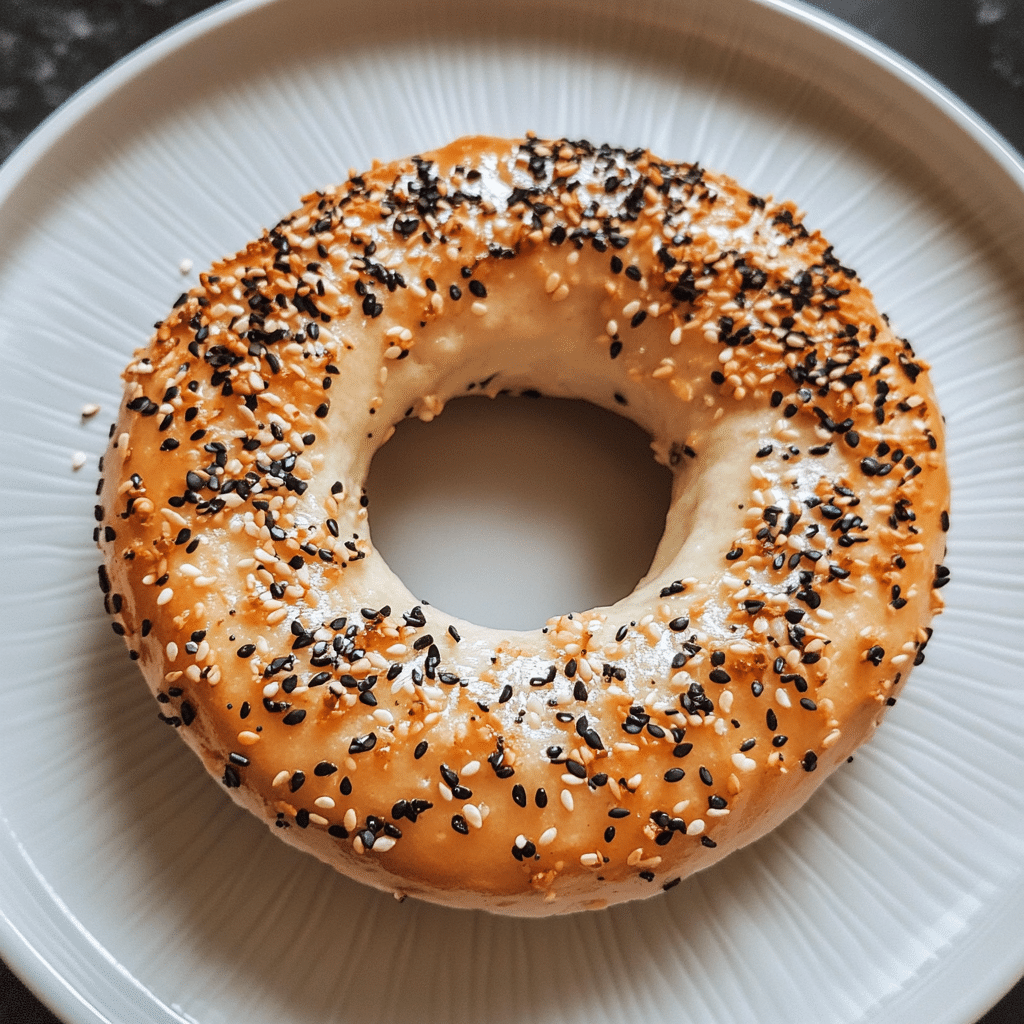
Homemade Protein Bagels – 2-Ingredient and Full Recipes
The Famous Two-Ingredient Protein Bagel Recipe
If you’ve spent any time on fitness blogs or Instagram, you’ve probably seen the viral 2-ingredient protein bagel recipe. It’s easy, affordable, and delivers solid nutrition—no yeast or long proofing needed.
✅ Ingredients:
- 1 cup self-rising flour
- 1 cup non-fat Greek yogurt
🔄 Optional Add-Ins:
- 1 scoop unflavored whey protein (adds ~20g protein)
- 1 tsp garlic powder or everything bagel seasoning
🥣 Directions:
- Preheat oven to 375°F (190°C).
- Mix the flour and yogurt in a bowl until a dough forms. Add whey protein if using.
- Knead until smooth, divide into 4 pieces.
- Roll into ropes and form into bagels.
- Place on a lined baking tray, brush with egg wash if desired.
- Bake for 25 minutes or until golden brown.
- Let cool before slicing and enjoy!
Each bagel delivers:
- 15–20g protein
- 150–200 calories
- Low fat and sugar
These are great pre- or post-workout snacks and can be frozen for meal prep.
Step-by-Step for Full Protein-Packed Bagel Variations
Looking for more flavor and versatility? Try these bulkier high-protein bagel recipes:
Cottage Cheese Protein Bagels:
- 1 cup cottage cheese
- 1 cup oat flour
- 1 scoop casein protein
- 2 eggs
Blend until smooth, shape into bagels, and bake at 350°F for 25–30 minutes. High in slow-digesting protein—great for nighttime snacks.
Almond Flour Keto Bagels:
- 2 cups almond flour
- 1 tsp baking powder
- 1/2 tsp xanthan gum
- 1 cup shredded mozzarella (melted)
- 1 egg
Keto-approved with under 5g net carbs per bagel, and still delivers 13g+ of protein.
Egg-Heavy Bodybuilder Bagels:
- 4 eggs
- 1/2 cup oat flour
- 2 scoops protein powder
- 1 tsp baking soda
- Dash of salt
Bake in silicone donut molds for a fluffier, eggier version that packs 25g+ protein per serving.
Pair any of these recipes with high-protein fillings (coming next!) for a complete meal.
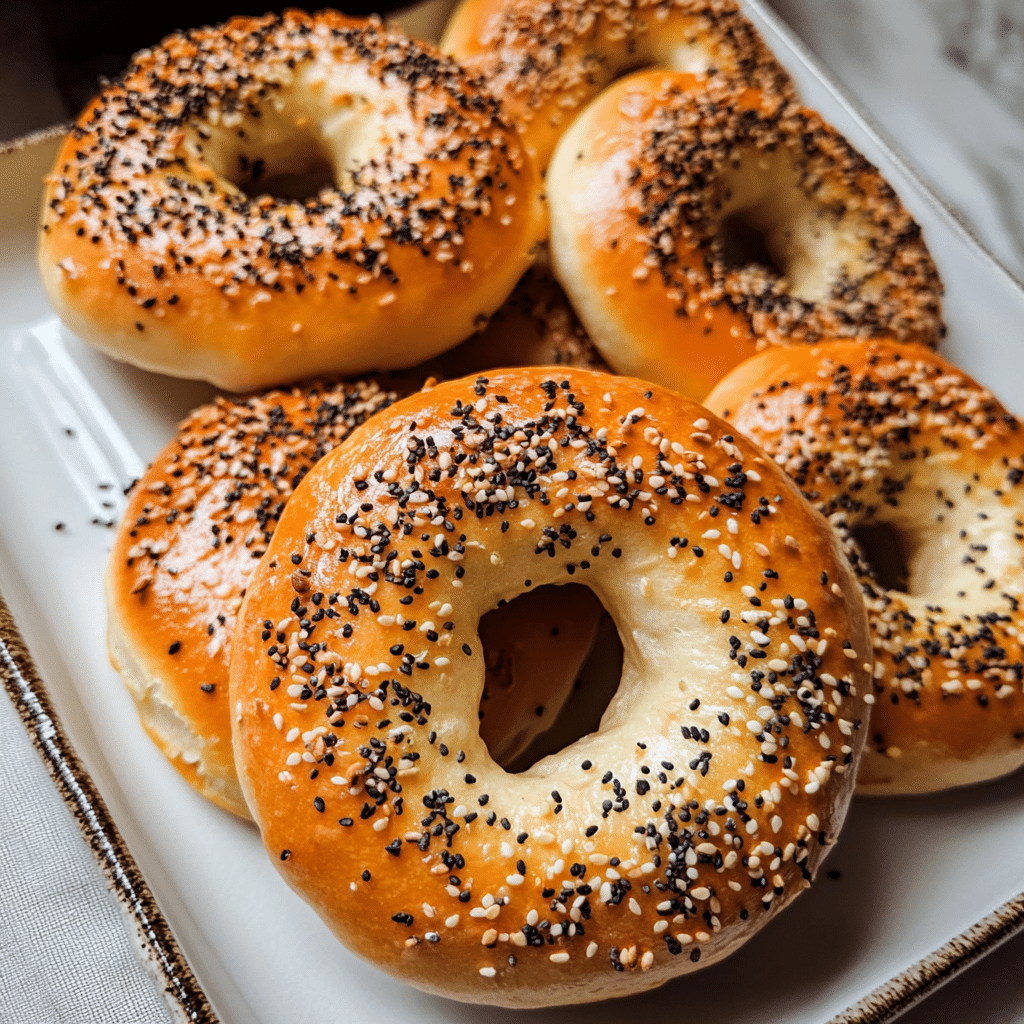
Topping Ideas – How to Add Even More Protein to Your Bagel
Spreads and Fillings for Maximum Protein Boost
What you put on your bagel matters just as much as what goes in it. Here are the top high-protein spreads and combos to supercharge your breakfast or snack:
Nut Butters (8–10g protein per 2 tbsp)
- Peanut, almond, or cashew butters add healthy fats and protein.
- For extra points, mix with a scoop of protein powder for a sweet spread.
Cottage Cheese or Cream Cheese + Greek Yogurt
- Whipped cottage cheese offers 11–14g protein per ½ cup and pairs well with savory toppings.
- Mix cream cheese with Greek yogurt for a fluffier, higher-protein alternative to plain spread.
Egg-Based Toppings
- Hard-boiled egg slices
- Scrambled eggs with herbs
- Egg salad made with Greek yogurt instead of mayo
Each of these can add 6–12g more protein to your bagel.
Avocado + Tuna or Chicken
- Half an avocado topped with canned tuna, shredded rotisserie chicken, or leftover salmon makes a high-protein, high-omega meal.
Don’t miss our guide to salmon sashimi for more delicious, protein-packed seafood inspiration!
Meat, Vegan, and Vegetarian High-Protein Options
No matter your diet, there’s a protein-rich topping combo that works:
| Diet Type | Topping Ideas | Protein (per serving) |
|---|---|---|
| Omnivore | Turkey bacon, deli turkey, roast beef, grilled chicken | 10–20g |
| Vegetarian | Egg salad, hummus + feta, Greek yogurt spread | 8–15g |
| Vegan | Tofu scramble, lentil spread, chickpea salad | 8–12g |
For an extra boost, sprinkle with:
- Hemp seeds (3g per tbsp)
- Nutritional yeast (4g per 2 tbsp)
- Pumpkin seeds (5g per 2 tbsp)
Top tip: Make an open-faced protein bagel sandwich with a layer of spread + protein + fresh veggies. It’s colorful, balanced, and packed with energy.
Check out our Pioneer Woman Cheeseburger Pie for more high-protein comfort food ideas.
When and How to Eat Protein Bagels for Fitness Goals
Best Time to Eat for Muscle Growth or Weight Loss
Timing your meals around your personal health goals can maximize the benefits of eating protein bagels. Here’s when to enjoy them based on what you’re aiming for:
For Muscle Gain
- Best Time: Post-workout (within 30–60 minutes)
- Why: Protein aids muscle repair, and carbs from the bagel help replenish glycogen.
- How: Choose a bagel with 20+g protein and pair it with a spread like cottage cheese or turkey slices.
For Weight Loss
- Best Time: Breakfast or mid-morning snack
- Why: A protein-rich breakfast reduces hunger later in the day, limiting calorie intake.
- How: Go for a low-calorie option like the 2-ingredient bagel with whipped Greek yogurt and chia seeds.
For Recovery or Nighttime Snack
- Best Time: Evening
- Why: Casein protein (from dairy like cottage cheese) digests slowly, feeding muscles overnight.
- How: Use a homemade bagel with cottage cheese or almond butter.
Here’s a sample fitness-friendly daily plan using protein bagels:
| Meal Time | What to Eat | Goal |
|---|---|---|
| Breakfast | Bagel + egg + avocado | Energy & satiety |
| Post-Workout | Bagel + Greek yogurt + fruit | Muscle growth |
| Evening Snack | Mini bagel + cottage cheese + berries | Overnight recovery |
Combining Bagels with Balanced Meals
While protein bagels are nutrient-dense, they shine brightest when paired with balanced side items:
- Add Fiber: Fresh veggies or greens help digestion and satiety.
- Healthy Fats: A smear of almond butter, olive oil drizzle, or avocado provides sustained energy.
- Micronutrients: Boost vitamins by including berries, peppers, spinach, or tomatoes.
Here’s an example of a balanced protein bagel plate:
Open-Faced Protein Bagel Bowl:
- 1 protein bagel
- 2 boiled eggs
- 1/2 avocado
- Handful of arugula + cherry tomatoes
- Sprinkle of pumpkin seeds
Total: ~30g protein, high fiber, under 400 calories
Comparing Protein Bagels vs Regular Bagels
Macronutrient Differences Explained
At first glance, bagels may all look the same. But when you compare regular bagels to protein bagels, the nutritional gap is wide—and it makes a big difference for your diet goals.
Here’s how they stack up:
| Nutrients | Regular Bagel (100g) | Protein Bagel (100g) |
|---|---|---|
| Calories | ~260 kcal | 170–220 kcal |
| Protein | ~9g | 15–25g |
| Carbs | ~50g | 20–35g |
| Fat | ~1g–2g | 2g–6g |
| Sugar | 4g–9g | 1g–4g |
Why Protein Bagels Win:
- Double or triple the protein
- Fewer empty carbs
- Longer satiety
- Often fortified with vitamins, minerals, and fiber
🚫 Why Regular Bagels May Fall Short:
- High glycemic index (causes sugar crashes)
- Mostly refined flour
- Offers minimal protein, especially for active lifestyles
So if you’re trying to manage weight, balance blood sugar, or stay full until lunch, protein bagels are a clear winner.
Taste, Texture, and Satiety Comparison
Now, let’s get honest about the eating experience. Are protein bagels as satisfying?
Taste
- Regular Bagels: Light, chewy, and often sweeter (especially cinnamon raisin, blueberry, etc.)
- Protein Bagels: Slightly denser and heartier with a savory bite, depending on ingredients like Greek yogurt or almond flour
Texture
- Regular: Traditional chew, glossy crust
- Protein: Can be chewier or breadier, depending on added whey or yogurt
Satiety
- Protein bagels keep you full for 3–4 hours
- Regular bagels often lead to hunger spikes within 1–2 hours
Verdict: While protein bagels may not always mimic the exact taste of a New York-style deli bagel, they absolutely win in nutritional impact and are delicious with the right toppings and pairings.
Protein Bagel Myths and Mistakes to Avoid
Misconceptions About “High-Protein” Marketing
Not all “protein bagels” live up to the hype. Some products are labeled “high-protein” but barely deliver more than a regular bagel. Here’s how to separate fact from fiction:
🚫 MYTH #1: All Bagels Labeled ‘High-Protein’ Are Healthy
Wrong. Many mass-market bagels add just a few grams of protein but still pack in 40–50g of refined carbs and added sugars. Always check:
- Protein per serving (aim for 15g+)
- Net carbs
- Fiber content
🚫 MYTH #2: Protein Bagels Are Only for Gym Buffs
Not true. These bagels are beneficial for anyone looking to stay full longer, stabilize blood sugar, or enjoy better nutrition in their daily meals.
🚫 MYTH #3: Homemade Protein Bagels Are Complicated
In reality, the 2-ingredient recipe is easier than most banana bread recipes—and faster, too.
Learn more about easy, nutritious hacks like our cornbread crumbling guide to avoid baking flops across all recipes.
Common Baking Mistakes That Lower Protein Content
Making protein bagels at home? Avoid these traps:
❌ Skipping Protein Powder Measurement
Guesswork leads to low-protein results. Stick to 1 scoop per batch for at least 20g total protein added.
❌ Using Regular Yogurt Instead of Greek
Regular yogurt has way more water and less protein. Use full-fat or non-fat Greek yogurt only.
❌ Overkneading the Dough
Especially when using almond or oat flour, overworking the dough can make the bagels tough and dry.
❌ Underbaking or Overbaking
Undercooked bagels may collapse; overbaking makes them rubbery. Follow a timer and look for golden brown, firm tops.
❌ Ignoring Storage Rules
High-protein bagels spoil faster due to the added moisture and dairy. Always:
- Cool completely before storing
- Refrigerate for up to 5 days
- Freeze in airtight bags for 1 month
What bagels are high in protein?
High-protein bagels typically contain added ingredients like whey protein, Greek yogurt, vital wheat gluten, or soy protein isolate. Some of the most protein-rich options include:
- The Better Bagel – up to 25g protein, low carb
- Aldi’s L’oven Fresh Protein Bagels – ~17g protein, budget-friendly
- Thomas’ Protein Bagels – 13g protein, widely available
- Homemade 2-ingredient bagels with added protein powder – up to 20g per serving
Always check the nutrition label—if it’s under 10g per bagel, it’s not really high-protein.
Why do Thomas bagels have so much protein?
Thomas’ Protein Bagels use vital wheat gluten and soy protein isolate—two dense protein sources that also help maintain a chewy, bread-like texture. This blend allows them to deliver 13g of protein without affecting the traditional bagel experience too much.
Additionally, Thomas adds enriched flour and stabilizers, which contribute to texture and shelf stability while preserving protein content.
What are the two ingredients in protein bagels?
The classic 2-ingredient protein bagel recipe includes:
- Self-rising flour
- Non-fat Greek yogurt
These two combine to create a dough that’s easy to shape, bake, and customize. Add 1 scoop of unflavored whey protein to increase the protein even more—making it a 3-ingredient, high-protein option.
FAQs About Protein Bagels Answered
High-protein bagels typically contain added ingredients like whey protein, Greek yogurt, vital wheat gluten, or soy protein isolate. Some of the most protein-rich options include:
The Better Bagel – up to 25g protein, low carb
Aldi’s L’oven Fresh Protein Bagels – ~17g protein, budget-friendly
Thomas’ Protein Bagels – 13g protein, widely available
Homemade 2-ingredient bagels with added protein powder – up to 20g per serving
Always check the nutrition label—if it’s under 10g per bagel, it’s not re
Thomas’ Protein Bagels use vital wheat gluten and soy protein isolate—two dense protein sources that also help maintain a chewy, bread-like texture. This blend allows them to deliver 13g of protein without affecting the traditional bagel experience too much.
Additionally, Thomas adds enriched flour and stabilizers, which contribute to texture and shelf stability while preserving protein content.
The classic 2-ingredient protein bagel recipe includes:
Self-rising flour
Non-fat Greek yogurt
These two combine to create a dough that’s easy to shape, bake, and customize. Add 1 scoop of unflavored whey protein to increase the protein even more—making it a 3-ingredient, high-protein option.
customize. Add 1 scoop of unflavored whey protein to increase the protein even more—making it a 3-ingredient, high-protein option.
Conclusion: Are Protein Bagels Worth It?
Absolutely. Whether you’re trying to eat cleaner, build lean muscle, or simply avoid a mid-morning energy crash, protein bagels are a smart, satisfying upgrade to your daily routine. With the flexibility to go store-bought or homemade, sweet or savory, high-protein bagels adapt to every diet and lifestyle.
And remember, it’s not just what’s in the bagel—it’s what you put on it. Use this guide to build smarter breakfasts, level up your meal prep, and take control of your nutrition, one bite at a time.
Don’t miss our ultimate guide to fish taco seasoning if you want to keep exploring creative, bold, and healthy flavor combos!
Follow us on Facebook for more high-protein recipes, healthy cooking tips, and smart breakfast swaps that fuel your day right.
